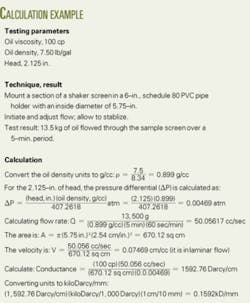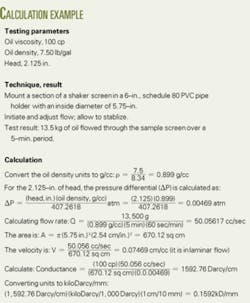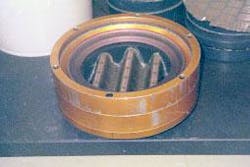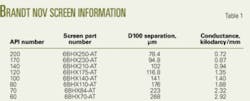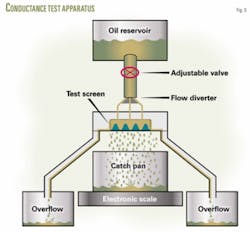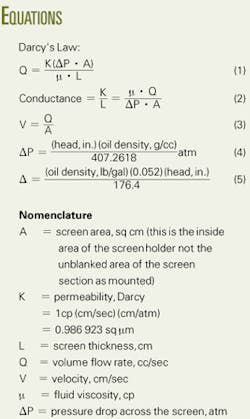The American Petroleum Institute has new guidelines for testing shaker screen conductance under static conditions. The first article in this series provided a practical guide to shaker screen selection using API RP 13C compliant screens (OGJ, Feb. 20, 2006, p. 46).
Shaker screen conductance is a measure of the ability of a Newtonian fluid to pass through the screen. The higher the conductance the easier it is for a given fluid to flow through the screen. It is analogous to permeability per unit thickness of the screen.
Old test method: API RP 13E
In the older API RP 13E document the conductance test uses a flow loop with a glycerin and water mixture in an isothermal bath. The fluid was pumped through a shaker screen’s individual layers of wire cloth, one at a time, and the conductance for the shaker screen (assembled) was a mathematical combination of the results for the individual layers.
This method has several drawbacks. It requires pressure gauges that measure pressure to the thousandth of a psi; it is greatly affected by temperature changes (hence the need for the isothermal bath); it requires a skilled technician to get repeatable results; and it is very expensive.
Since the conductance of the individual layers was mathematically combined, the order in which the layers were tested was not considered significant. Subsequent testing, however, shows that it does indeed make a difference in the conductance when the screens are layered differently.
New test method: API RP 13C
The goal of the revision committee was to create a conductance test that was simple and inexpensive, yet accurate. The new test isn’t as simple and inexpensive as the separation test described in Part 1 of this series, but it is simpler and less expensive when compared to the method it replaced (API RP 13E).
The new API RP 13C test method recommends using motor oil (such as 10/40 weight) as the testing fluid because:
• A viscous fluid is needed to maintain the flow in the laminar range.
• It has additives that will oil-wet the screen in case there is any water adhering to the screen wires.
The density and viscosity of oil changes with temperature, so that calibration charts need to be prepared accordingly for calculating flow rate and permeability.
The testing apparatus has a holder that accepts the same mounted screen that is used for the separation test (Fig. 1). This means the screen is tested as constructed instead of using a mathematical model. As with the separation test, if something new is invented the test will handle it and not become out dated.
Testing
The mounted shaker screen is installed level in the holder (Fig. 2) and oil is flowed onto the screen. The rate is adjusted with the valve so there is a slight amount of overflow. This ensures there is a constant pressure across the screen.
After the flow rate stabilizes, the electronic scale (connected to a computer) can record the weight per unit time, while a sensor probe records the temperature of the oil.
The density and viscosity of the oil for a given temperature can be read from the charts. These data are used to calculate the permeability and conductance of the test screen.
Calculations
Darcy’s Law provides the method of calculating the permeability of a porous medium. A permeability of 1 Darcy will allow the flow of 1 cc/sec of fluid of 1 cp viscosity through an area of 1 sq cm under a pressure gradient of 1 atm/cm (Equation 1).
A Darcy is a unit of permeability through a porous medium and a shale shaker’s screen could be considered a porous medium. The permeability divided by the thickness or length of flow is called conductance and has units of kiloDarcy’s per millimeter (kD/mm)
Equation 2 shows the solution for Darcy’s Law for the ratio of permeability, K, per unit length, L, or conductance, C.
The velocity of the fluid through the screen must be laminar to provide reproducible results. Therefore, the velocity must be maintained at less than 3 cm/sec. Equation 3 calculates the velocity of the fluid.
Darcy’s Law requires the pressure differential (∆P) to be expressed in atmospheres of pressure. If the head is measured in inches, then either Equation 4 or Equation 5 shows the pressure differential in atmospheres.
A calculation box provides an example of a shaker-screen calculation. The conductance for the screen tested is 0.1592 kD/mm. This is a very low conductance number and would probably be associated with a screen classified as API 400 or API 450.
Changes that affect conductance
In a comparison of flat screens, changes in the API number indicate changes in conductance. As the API number gets smaller the openings get larger and conductance increases.
Other ways to increase conductance are as follows:
1. Use wire cloth with rectangular openings instead of square openings. This means more opened area due to the reduction in wire (exaggerate this too much and the cloth will be unstable).
2. Use less bonding material, which increases the nonblanked area (screen life could be reduced).
3. Use smaller diameter wires, which increase the opened area (screen life will probably be reduced).
4. Use corrugated screens (i.e., Pyramid), which pack more screen in the test holder (Fig. 2)
Screen comparisons
Most screen manufacturers have tested or are in the process of testing their screens using the new API procedures. Some are still deciding if they will comply, while others have no intention at present of complying. Two companies that shared information on API RP 13C testing for inclusion in this article were Brandt, a division of NationalOilwellVarco (Table 1) and Derrick Equipment Co. (Table 2). Other major screen manufacturers declined to participate.
The information in Tables 1 and 2 is preliminary from the respective screen manufacturers and subject to change. For the most current information, contact the screen manufacturers.
It is important to remember that just as in the separation test; this is not a performance test. This test is done under static conditions (the screen is stationary). A fluid free of solids (such as motor oil) is flowed through the screen, driven by gravity. This is intended for relative comparisons of the screens under the same conditions.
Actual performance of the screen in field conditions will depend on several factors:
1. The drilling fluid properties.
2. The size, shape, and quantity of solids present in the mud.
3. Other properties of the solids (sticky cuttings, water-wet solids in a nonaqueous fluid, etc.).
4. The shale shaker’s operating parameters (basket angle, flow rate, G force, stroke length, and vibration frequency of the shaker).
For these reasons performance cannot be predicted from the conductance value, but performance will be relative and higher conductance screens will permit more flow when compared to lower conductance screens.
This information will take a lot of the guesswork out of choosing screens as conditions change.
If a specific separation is required (such as an API 170 screen) but a drier cuttings discharge is desired, then pick an API 170 screen with a higher conductance number than currently being used.
If improvement in screen life is desired then generally pick a screen with lower conductance. This is good information comparing like screen to like screen, such as flat to flat. It gets more complicated if comparing flat screens to corrugated screens, such as the Derrick Pyramid screens. For those situations, contact the screen manufacturers for additional information.
By selecting API compliant screens for your drilling operation you know what you are getting and there will be no surprises. The uniformity makes screen comparison and evaluation much easier by eliminating the confusion caused by misleading labeling.
Acknowledgment
I thank the management of Chevron Energy Technology Co. for permission to publish this article, Leon Robinson for help and suggestions, and Derrick Equipment Co. and Brandt NOV for supplying separation and conductance data. ✦
